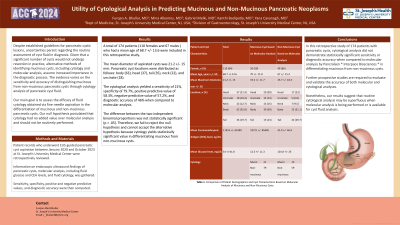Sunday Poster Session
Category: Biliary/Pancreas
P0032 - Utility of Cytological Analysis in Predicting Mucinous and Non-Mucinous Pancreatic Neoplasms
Sunday, October 27, 2024
3:30 PM - 7:00 PM ET
Location: Exhibit Hall E

Has Audio

Furqan A. Bhullar, MD
St. Joseph's University Medical Center
Presenting Author(s)
Furqan A. Bhullar, MD, Mina Alkomos, MD, Gabriel Melki, MD, Kanthi Rekha Badipatla, MD, Yana Cavanagh, MD
St. Joseph's University Medical Center, Paterson, NJ
Introduction: Despite established guidelines for pancreatic cystic lesions, uncertainties persist regarding the routine assessment of cyst fluid in diagnosis. Given that a significant number of cysts would not undergo resection in practice, alternative methods of identifying mucinous cysts, including cytology and molecular analysis, assume increased importance in the diagnostic process. The evidence varies on the sensitivity and accuracy of distinguishing mucinous from non-mucinous pancreatic cysts through cytology analysis of pancreatic cyst fluid. Our main goal is to assess the efficacy of fluid cytology obtained via fine needle aspiration in the differentiation of mucinous and non-mucinous pancreatic cysts.
Methods: Patient records who underwent EUS-guided pancreatic cyst aspiration between January 2020 and October 2023 at St. Joseph’s University Medical Center were retrospectively reviewed. Information on endoscopic ultrasound findings of pancreatic cysts, molecular analysis, including fluid glucose and CEA, and fluid cytology, was gathered. Sensitivity, specificity, positive and negative predictive values, and diagnostic accuracy were then computed.
Results: A total of 174 patients (110 females and 67 males ) who had a mean age of 68.7 +/- 13.6 were included in this retrospective study. The mean diameter of aspirated cysts was 21.2 +/- 15 mm. Pancreatic cyst locations were distributed as follows: body (63), head (37), tail (35), neck (22), and uncinate (18). The cytological analysis yielded a sensitivity of 21%, specificity of 79.7%, positive predictive value of 58.3%, negative predictive value of 57.2%, and diagnostic accuracy of 46% when compared to molecular analysis. The difference between the two independent binomial proportions was not statistically significant (p > .05). Therefore, we fail to reject the null hypothesis and cannot accept the alternative hypothesis because cytology yields statistically significant value in differentiating mucinous from non-mucinous cysts.
Discussion: In conclusion, in this retrospective study of 174 patients with pancreatic cysts, cytological analysis demonstrated limited sensitivity and diagnostic accuracy when compared to molecular analysis, with no statistically significant difference observed, suggesting a challenge in differentiating mucinous from non-mucinous cysts.
Note: The table for this abstract can be viewed in the ePoster Gallery section of the ACG 2024 ePoster Site or in The American Journal of Gastroenterology's abstract supplement issue, both of which will be available starting October 27, 2024.
Disclosures:
Furqan A. Bhullar, MD, Mina Alkomos, MD, Gabriel Melki, MD, Kanthi Rekha Badipatla, MD, Yana Cavanagh, MD. P0032 - Utility of Cytological Analysis in Predicting Mucinous and Non-Mucinous Pancreatic Neoplasms, ACG 2024 Annual Scientific Meeting Abstracts. Philadelphia, PA: American College of Gastroenterology.
St. Joseph's University Medical Center, Paterson, NJ
Introduction: Despite established guidelines for pancreatic cystic lesions, uncertainties persist regarding the routine assessment of cyst fluid in diagnosis. Given that a significant number of cysts would not undergo resection in practice, alternative methods of identifying mucinous cysts, including cytology and molecular analysis, assume increased importance in the diagnostic process. The evidence varies on the sensitivity and accuracy of distinguishing mucinous from non-mucinous pancreatic cysts through cytology analysis of pancreatic cyst fluid. Our main goal is to assess the efficacy of fluid cytology obtained via fine needle aspiration in the differentiation of mucinous and non-mucinous pancreatic cysts.
Methods: Patient records who underwent EUS-guided pancreatic cyst aspiration between January 2020 and October 2023 at St. Joseph’s University Medical Center were retrospectively reviewed. Information on endoscopic ultrasound findings of pancreatic cysts, molecular analysis, including fluid glucose and CEA, and fluid cytology, was gathered. Sensitivity, specificity, positive and negative predictive values, and diagnostic accuracy were then computed.
Results: A total of 174 patients (110 females and 67 males ) who had a mean age of 68.7 +/- 13.6 were included in this retrospective study. The mean diameter of aspirated cysts was 21.2 +/- 15 mm. Pancreatic cyst locations were distributed as follows: body (63), head (37), tail (35), neck (22), and uncinate (18). The cytological analysis yielded a sensitivity of 21%, specificity of 79.7%, positive predictive value of 58.3%, negative predictive value of 57.2%, and diagnostic accuracy of 46% when compared to molecular analysis. The difference between the two independent binomial proportions was not statistically significant (p > .05). Therefore, we fail to reject the null hypothesis and cannot accept the alternative hypothesis because cytology yields statistically significant value in differentiating mucinous from non-mucinous cysts.
Discussion: In conclusion, in this retrospective study of 174 patients with pancreatic cysts, cytological analysis demonstrated limited sensitivity and diagnostic accuracy when compared to molecular analysis, with no statistically significant difference observed, suggesting a challenge in differentiating mucinous from non-mucinous cysts.
Note: The table for this abstract can be viewed in the ePoster Gallery section of the ACG 2024 ePoster Site or in The American Journal of Gastroenterology's abstract supplement issue, both of which will be available starting October 27, 2024.
Disclosures:
Furqan Bhullar indicated no relevant financial relationships.
Mina Alkomos indicated no relevant financial relationships.
Gabriel Melki indicated no relevant financial relationships.
Kanthi Rekha Badipatla indicated no relevant financial relationships.
Yana Cavanagh indicated no relevant financial relationships.
Furqan A. Bhullar, MD, Mina Alkomos, MD, Gabriel Melki, MD, Kanthi Rekha Badipatla, MD, Yana Cavanagh, MD. P0032 - Utility of Cytological Analysis in Predicting Mucinous and Non-Mucinous Pancreatic Neoplasms, ACG 2024 Annual Scientific Meeting Abstracts. Philadelphia, PA: American College of Gastroenterology.
